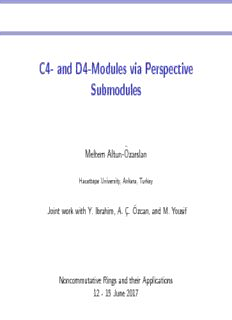
C4- and D4-Modules via Perspective Submodules PDF
Preview C4- and D4-Modules via Perspective Submodules
C4- and D4-Modules via Perspective Submodules Meltem Altun-O¨zarslan HacettepeUniversity,Ankara,Turkey Joint work with Y. Ibrahim, A. C¸. O¨zcan, and M. Yousif Noncommutative Rings and their Applications 12 - 15 June 2017 Outline Background 1 C4-Modules via Perspective Submodules 2 Endomorphism Rings of C4-Modules 3 Right C4 rings 4 D4-Modules via Perspective Submodules 5 Background Definition Let R be a ring and M a right R-module. M iscalledaCi-moduleifithasthefollowingCi propertiesfori =1,2,3. C1: Every submodule of M is essential in a direct summand of M. C2: Whenever A and B are submodules of M with A∼=B and B ⊆⊕ M, then A⊆⊕ M. C3: Whenever A and B are direct summands of M with A∩B =0, then A+B ⊆⊕ M. Background Definition Let R be a ring and M a right R-module. M iscalledaCi-moduleifithasthefollowingCi propertiesfori =1,2,3. C1: Every submodule of M is essential in a direct summand of M. C2: Whenever A and B are submodules of M with A∼=B and B ⊆⊕ M, then A⊆⊕ M. C3: Whenever A and B are direct summands of M with A∩B =0, then A+B ⊆⊕ M. Background Definition Let R be a ring and M a right R-module. M iscalledaCi-moduleifithasthefollowingCi propertiesfori =1,2,3. C1: Every submodule of M is essential in a direct summand of M. C2: Whenever A and B are submodules of M with A∼=B and B ⊆⊕ M, then A⊆⊕ M. C3: Whenever A and B are direct summands of M with A∩B =0, then A+B ⊆⊕ M. Background Definition Let R be a ring and M a right R-module. M iscalledaCi-moduleifithasthefollowingCi propertiesfori =1,2,3. C1: Every submodule of M is essential in a direct summand of M. C2: Whenever A and B are submodules of M with A∼=B and B ⊆⊕ M, then A⊆⊕ M. C3: Whenever A and B are direct summands of M with A∩B =0, then A+B ⊆⊕ M. Background Definition A module M is called a Di-module if it satisfies the following Di-conditions. D1: For every submodule A of M, there is a decomposition M =M ⊕M such that M ⊆A and A∩M (cid:28)M . 1 2 1 2 2 D2: Whenever A and B are submodules of M with M/A∼=B and B ⊆⊕ M, then A⊆⊕ M. D3: Whenever A and B are direct summands of M with A+B =M, then A∩B ⊆⊕ M. Background Definition M is called continuous if it is C1 and C2, and quasi-continuous if it is C1 and C3. C2 ⇒ C3 quasi-injective ⇒ continuous Definition A module M is called discrete if it is both a D1- and a D2 -module, quasi-discrete if it is both a D1- and a D3-module. quasi-projective ⇒ D2 ⇒ D3 Background Definition M is called continuous if it is C1 and C2, and quasi-continuous if it is C1 and C3. C2 ⇒ C3 quasi-injective ⇒ continuous Definition A module M is called discrete if it is both a D1- and a D2 -module, quasi-discrete if it is both a D1- and a D3-module. quasi-projective ⇒ D2 ⇒ D3 C4-Modules via Perspective Submodules Proposition [Amin et al., 2015] If M is a C3-module, then for every decomposition M =A⊕B and every homomorphism f :A→B with kerf ⊆⊕ A, then Imf ⊆⊕ B. [Amin et al., 2015] The following are equivalent for a module M: (1) If M =A⊕B and f :A→B is a monomorphism, then Imf ⊆⊕ B. (2) If M =A⊕B and f :A→B is a homomorphism with kerf ⊆⊕ A, then Imf ⊆⊕ B.
Description: